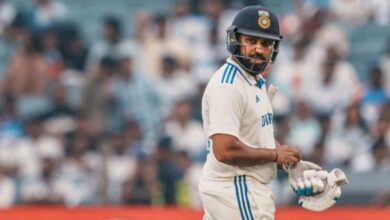Sacrilege: But is An Sai Long better than even Lin Dan – after the 2024 Olympics gold? | Badminton News

You might not have heard of An Sai Long, the double Olympic champion, but China has. And he could stake claim to being better than the great Lin Dan, and even the Chinese won’t mind a ponder over that debate. It’s the Mandarin name adopted Viktor Axelsen when he was 22 and became proficient in the language, proficient enough to charm the Chinese speaking to them in their tongue, after losing the Rio Olympics semifinal to Chen Long. The next day, he had earned their ungrudging respect beating Lin Dan for the 2016 Olympics bronze. Over the next 8 years, the time he turned 30, Axelsen had equalled Super Dan to two Olympic titles, though his total Games medal count was one more than Dan – thanks to himself, for Axelsen had denied the greatest Chinese his third possible medal at Rio, after golds at Beijing and London.
The World Championships count is still heavily skewed in favour of Lin Dan – his 5 world titles dwarfing out Axelsen’s 2. And the super southpaw of China, perhaps the player with the most lasting game-recall across generations, took his country to a staggering 6 Thomas Cups compared to just the 1 from Axelsen. But no one can deny that with his superior Olympic medal count (Lee Chong Wei has 3 too, but all silvers), Axelsen stomps into the debate with a rightful claim to the ‘greatest’ tag.
The world will remain in thrall of the Lin Dan-Lee Chong Wei era, which is badminton’s best cult secret, while coinciding with the Federer-Nadal times in tennis. Badminton is a much quieter sport due to its Asian fan base, but even those outside the magnificent Asian shuttleverse who know it edgeways, knew it solely for Lin Dan and Lee Chong Wei. Axelsen a.k.a An Sai Long, though, fetched up not too differently than a Novak Djokovic, to establish a third supremacy of his own, and in the 2024 season with that Olympic gold at Paris, opened the tennis-drowsed eyes of the West to the brilliance of this sport.
From when Axelsen was getting sharp on his Mandarin – there’s a famous incident of him responding to a Chinese fan giggling about his height, in an elevator oblivious to him knowing her language, and startling her out of her wits. The charm and the offensive would both plunge Chinese men’s singles badminton into a flux with missed medals and lost dominance.
For one, Axelsen boasts of a win against the magician Bao Chunlai, arguably their most stylish player. Then there’s the business with Lin Dan, not just denying him a medal, but a superior head to head record of 6-3. Perhaps the only Chinese who troubled Axelsen was Chen Long, who beat him 14 times, and lost just 6 – while delaying Axelsen’s elevation to the dominant beast he is now. But even Chen Long was humbled at the Tokyo Olympics, losing to the Dane in the final.
At Paris, China’s men’s singles players drew a blank. And Shi Yuqi’s misfortune lies in him playing in the Axelsen era – he trails the Dane 3-6.
That is An Sai Long’s dominance over 3 generations of Chinese top contenders – Lin Dan, the eventual gold nicked away from Chen Long and an utter stranglehold over Shi Yuqi.
Mandarin might be the only foreign language he mastered, perhaps strategically (for he has admitted to benefitting from understanding instructions of Chinese coaches who might not immediately grapple with a 6’4″ European, with grey blue eyes knowing exactly what they are hollering about). But Axelsen’s game-smarts went beyond – in his temporary stint, living and training in Dubai, he cleverly invited the Gen next – Lakshya Sen (8-1), Kunlavut Vitidsarn (7-1), Loh Kean Yew (9-2), Lee Zii Jia (7-3) and assorted others, for short sparring camps. And though he might have lost to them in inconsequential matches on the Tour, he never allowed them ‘juniors any leeway in the big finals – All England and Olympics and World Championships.
Axelsen could also be said to have been at the right place, at the right time, given Kento Momota’s wretched luck (the Japanese was 14-3 up), and Lee Chong Wei’s exit (11-3 up). Lee Hyun-il, now Sindhu’s coach, beat Axelsen thrice, losing just once, and though Srikanth (3-10 down) and Sen have asmal records against the great Dane, India has a bit of a gloat-over-the GoAT record — Parupalli Kashyap went 2-2 against him, and HS Prannoy famously denied him the 2023 World Championship medal with a masterly tactical takedown in the quarters.
Axelsen is strangely yet to face Chinese Li Shifeng – modelled on Chen Long, and that will be a matchup with plenty of popcorn crunch. But he has knocked off Kodai Naraoka 6-0, completing a total chokehold over the yuppie, next young generation. They just don’t have his determination and doggedness, as he can overpower them at their own games – as varied as ultra-defensive Naraoka and hyper-attacking Lee Zii Jia. Still, the Malaysian really got on Axelsen’s nerves at the 2021 All England final which Zii Jia won in 3, including a 30-29 first set, where Axelsen made him labour over 8 stunning set points.
Perhaps where Lin Dan scores over Axelsen is in the momentous faceoffs with Chong Wei, the rivalry elevating both to stardom beyond badminton’s diehards.
Viktor Axelsen has no foil, though it can be argued that he has breathtakingly muzzled the entire field with his careful dismantling of every challenger. His greatness lies in being able to shape-shift between different styles, with immense shuttle control on his backhand front court play, economy of movements and a truly monster-smash that ends all resance. In his efficiency he’s exactly like Lin Dan, though the Chinese had a few more trick shots and sublime skills up his sleeve.
Super Dan’s stature is such that it’s sacrilege to broach any name in the same breath. But the Super Dane, with the Chinese name of An Sai Long, will always have that extra bronze.






